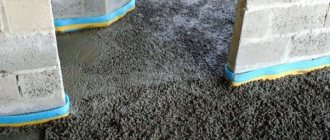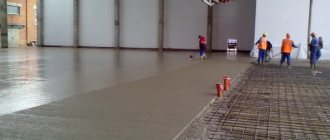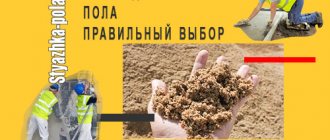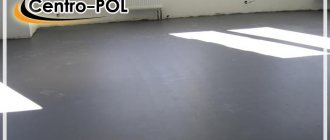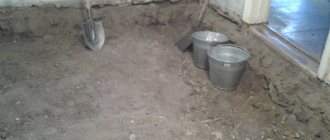Composition of sand concrete and main areas of application
Sand concrete is structural concrete. Refers to heavy, fine-grained concrete mixtures, which are widely used in repair and construction work. Its difference from lightweight concrete is the absence of large porous fillers in the composition of sand concrete.
Contains:
- Portland cement,
- sand of different fractions (up to 5 mm),
- water,
- additives to improve the characteristics of the mixture.
Portland cement is produced by grinding clinker and gypsum. Clinker is a product of firing a mixture of limestone (shell rock, chalk, limestone tuff, marble) and clay (loam, shale) in proportions, respectively, 75-78% to 22-25%. Corrective additives are used: bauxite, opoka, pyrite cinders, tripoli. Silicates and aluminates are added to increase strength.
Depending on the size of the filler - river or quartz sand - fine-, medium- and coarse-grained sand concrete is distinguished. The smaller the fraction, the more plastic and less durable the cement-concrete mixture.
The concentration of components in the finished substance is influenced by the brand of cement used and its shelf life, the moisture content of the sand, the purpose of the finished solution and its priority properties. Depending on the purpose of using the sand mixture, when preparing it, add 2-5 parts of sand of the required fraction to 1 part of Portland cement. Cement grades not lower than M300 are used. If necessary, additives and additives are included in the composition of sand concrete, the most common of which are:
- plasticizers - improve the plasticity and mobility of the mixture without adding excess water;
- fiber fiber – increases the strength of the concrete mixture, reduces shrinkage cracking;
- anti-corrosion additives – protect reinforcement in concrete and its surface from corrosion;
- granite chips – increases chipping strength.
The exact dosage of sand concrete components is selected by manufacturers experimentally and depends on the raw materials used and production technology. Different manufacturers have different proportions and additives, different quality of incoming raw materials. When choosing a sand mixture, it is necessary to give preference to reliable manufacturers with proven product quality, because “handicraft” production of the mixture can significantly affect the properties and, most importantly, the strength of the resulting concrete.
The main purpose is to use different grades with different properties at different stages of construction.
What is sand concrete used for:
- rough finishing of premises (plastering internal surfaces, installing floor screed in an apartment or house, plastering from the street);
- construction of foundations of different loads;
- construction of floors, frames, monolithic walls and other durable structures.
Depending on the proportions of the incoming components, compliance with the technologies for mixing and laying the solution, as well as the required temperature and humidity when pouring the screed and during the concrete hardening period, adding chemical or mineral additives, you can achieve the desired result with the characteristics stated in GOSTs.
Sand concrete grades: technical characteristics and properties
The main property that determines whether a mixture belongs to a particular brand of sand concrete is the level of compressive strength.
Compliance of the concrete mix grade with the compressive strength class
| Concrete strength class | Average strength of this class, kgf/sq.cm | Nearest brand of concrete |
| B 7.5 | 65 | M100 |
| AT 10 | 98 | M150 |
| At 12.5 | 131 | M150 |
| At 15 | 164 | M200 |
| IN 20 | 262 | M250 |
| At 22.5 | 295 | M300 |
| At 25 | 327 | M350 |
| At 27.5 | 360 | M350 |
| At 30 | 393 | M400 |
| At 35 | 458 | M450 |
| At 40 | 524 | M550 |
The strength class of sand concrete is indicated by the Latin letter “B” and numbers that indicate the withstand pressure in megapascals (MPa). This figure was obtained experimentally and means that with a 95% probability, a concrete mixture of a certain composition will withstand the specified pressure after the final hardening period.
In addition to the strength class, the brand of sand concrete has such characteristics as water resistance, frost resistance of concrete and mobility of the mixture.
Water resistance is the ability of hardened concrete not to allow water to pass through under a certain pressure. It is designated by the Latin letter “W” and a number from 2 to 20. For example, a sand concrete structure with water resistance W4 does not allow water to pass under a pressure of 0.2 MPa, but when the pressure increases, moisture accumulates inside it, which is unacceptable, as it can lead to a breakdown in strength designs. If the value of this parameter is low, it is necessary to take measures to waterproof the surface. The indicator depends on the water-cement ratio (W/C), the brand of cement, the presence of special additives, the fulfillment of the conditions for hardening the mixture, and the age of the concrete. They increase the water resistance of concrete by vibration, centrifugation and other mechanical methods of concrete compaction. The indicator also increases when additives such as aluminum sulfate, iron sulfate, and calcium nitrate are added to the sand mixture.
The grade of sand concrete in terms of frost resistance is designated by the Latin letter “F”. The number next to the letter shows the maximum number of cycles of freezing followed by thawing of concrete, which it can withstand without losing a level of compressive strength of more than 5%, taking into account the age of the concrete. There are 11 grades of concrete with a frost resistance range from F50 to F1000. The high rate allows the material to be used outdoors, regardless of weather conditions.
Sand mixture mobility is the ability of concrete to spread spontaneously under its own weight or under external influence. The balance of mobility and exfoliation of the mixture is important. An indicator of mobility is the cone slump, which is used to determine the workability of concrete (from P1 to P5). The higher the number, the more fluid the mixture.
Brands of sand concrete also differ in the type of filler (fraction and type of sand) and the presence of additives that improve the properties of the sand mixture and hardened concrete.
Areas of application of sand concrete grades
Depending on the composition of the mixture, sand concrete grades are distinguished from M100 to M600, the main distinguishing characteristic of which is their compressive strength. The higher the number, the greater the strength. The scope of application of the sand mixture depends on this indicator.
Areas of application of the main grades of sand concrete
| Brand of sand concrete | Areas of application |
| M100 | Rough leveling of indoor surfaces (plastering) Sealing cracks and defects in floors, walls, ceilings |
| M150 | Leveling surfaces Repairing cracks and defects in floors, walls, ceilings Laying the base for laying tiles Floor screed device without heavy weight loads under linoleum and carpet |
| M200 | Arrangement of floor screed for laminate, parquet and parquet boards, tiles and porcelain stoneware and other finishing coatings Leveling and repair of surfaces |
| M250 | Pouring screed over a heated floor system under laminate, parquet, tiles, porcelain tiles and other folk coverings Construction of cellars and basements Construction of monolithic walls, floor slabs, sidewalks and outdoor paths |
| M300 | Universal sand mixture for floor screeding of any premises, including industrial ones; M300 mixture for screed is optimal for laying heated floors Construction of strip foundations Construction of floor slabs, including strengthening of balconies and monolithic walls. Construction of concrete platforms, stairs, passages, sidewalks |
| M350 | Strip and slab foundations of multi-storey buildings Construction of floor slabs, monolithic walls, support columns, beams Road slabs Reinforced concrete products |
| M400, M450, M500 | Construction of bridges, piers, overpasses Construction of hydraulic structures, swimming pools Construction of multi-storey buildings: foundations, floors, walls Load-bearing reinforced concrete structures, piles, beams, arches, crossbars Construction of special-purpose facilities, including bomb shelters |
Adding plasticizers and additives to sand mixtures increases their strength, water resistance, frost resistance and improves other physical properties of the mixture.
Instructions for use
When choosing M300 sand concrete for construction work, the instructions for use must be read carefully. If for some reason it is not available, you should follow the recommendations of specialists:
- to mix the solution, use water at a temperature from 18°C to 20°C;
- the proportions of dry matter and water are affected by the composition of the material, so you must follow the manufacturer’s advice (more often, for every 10 kg of dry matter, 1.7 liters of water are required);
- pour the dry mixture into a container filled with water, constantly stirring (until the lumps completely disappear) with a drill with a special attachment;
- the resulting mass must have high plasticity;
- Before use, the solution must be allowed to brew (5-10 minutes);
- laying the mortar should be carried out at temperatures from 5°C to 25°C (mortar with frost-resistant additives can be used at temperatures down to -15°C);
- to increase adhesion, the base must first be cleaned and prepared (remove deformations, small cracks);
- The prepared solution must be used within 2-3 hours;
- joints adjacent to structures must be reinforced, and the finished mortar must be compacted;
- hardening occurs after 1 day, maximum strength after 28 days.
READ MORE: Grinding machine for concrete and wood floors surface treatment technology
Quite often you can come across a fake of such material.
During construction, reinforced concrete slabs are used as floors. The slab has a flat surface on one side, and the bottom with the cracks must be leveled. The disadvantages include the presence on sale of low-quality mixtures (counterfeits) and a large volume of products in paper bags packed up to 50 kilograms.
The advantages of using sand concrete include:
- rapid hardening;
- increased wear resistance;
- resistance to humidity and temperature changes, frost resistance (50 cycles);
- heat and sound insulation;
- no surface shrinkage;
- increased adhesion to materials (4 kg/cm2);
- use both for interior work indoors and for exterior decoration;
- low price.
The advantages of this material are based on its properties.
The brand of the composition is selected depending on its purpose. The higher the grade, the higher the strength characteristics of the building material.
Marking of dry sand concrete compositions, brief characteristics, purpose:
- M100 is a moisture-proof concrete that is used for leveling the floor surface, sealing defects and plastering bases. After hardening, it can withstand loads of up to 100 kg per 1 cm². The mixture contains a reduced proportion of cement and no limestone, making the material affordable.
- M150 is a composition of wide application. It is often used for plastering and facade work. Strength is 150 kg/cm², which makes it possible to use the composition for making brickwork and arranging floor screeds. To produce cement powder of this brand, sand with a fraction of up to 2 mm is used. The material additionally contains modifying additives that increase its performance characteristics. M150 is divided into universal, plastering, masonry, and specialized compounds.
- M200 - the material is used for interior work and installation of a “warm floor” system. It contains sifted quartz sand. After hardening, the coating can withstand loads of up to 0.2 t/cm². M200 is highly resistant to local deformations.
- M300 is a dry mixture that is used for the construction of high-strength concrete structures, interfloor slabs of buildings, for the arrangement of loaded foundations, floor screeds in industrial premises and the construction of load-bearing monolithic walls of structures.
- M400 (500) is a high-strength composition, capable of withstanding loads of up to 0.5 t/cm², and is widely used in the construction of multi-storey buildings and industrial facilities. It is used for reinforced concrete structures and the construction of residential buildings. The composition has increased the amount of cement.
Small portions of sand concrete can be mixed yourself, but if a large volume is required, then it is better to use the solution preparation service from the manufacturer with delivery to the site.
Which brand is best for floor screed in an apartment?
The variety of building material brands and their similar characteristics raise the question of which sand concrete is best for floor screed. The most popular brand of sand concrete is M300, which has universal characteristics for a wide range of applications in private construction and renovation. It is widely used for leveling floors in residential and industrial premises with different weight and temperature loads.
To screed the floor in the apartment, sand concrete grades M200 and M250 are used. If there are heated floors, pour a solution of M250 or M300.
Sand mixture M300 has low water permeability and good frost resistance, so it is often used to level the floor in the bathroom or on a cold balcony.
Calculation of sand concrete consumption for floor screed
Screed is one of the first and main rough jobs during a major renovation of an apartment or house. To level the floor, tons of concrete mixture are consumed. Manufacturers offer the following options for dispensing sand concrete: bags of 25, 30, 40, 50 kg; large bags of 1000 kg; in bulk.
Despite the fact that the cost of the material is affordable, a large volume will be needed. This must be taken into account when planning delivery and pick-up.
To calculate the required amount of dry concrete mixture you need:
- Determine the area that will be filled with screed. The square footage of the apartment or house is taken from the technical plan of the premises.
- Determine the degree of floor unevenness. It can differ not only throughout the entire object, but also within the room. The average value is taken: the required height of the screed is measured at the highest and lowest points, at several other arbitrary points, and the arithmetic mean is calculated from these data.
- Calculate the required amount of dry material to level the entire floor surface. The mixture consumption rate is indicated by the manufacturer.
For example, to level a floor with an average screed thickness of 4 cm in an apartment with an area of 60 square meters, you will need 4 * 60 * 20 = 4800 kg of dry sand mixture, calculating that for 1 m2 of screed 1 cm thick, about 20 kg of the mixture will be required.
Important! Manufacturers indicate the exact consumption of dry material and the proportions of dilution with water on the packaging.
Consumption
The number of workers requires preliminary calculation. It is better that there is enough solution, since it is undesirable to interrupt the process of pouring the screed. On the other hand, an excess of material leads to unnecessary costs.
The need for concrete depends on:
- layer thickness;
- size of the building;
- preparation of the base, presence of irregularities.
Calculation scheme:
- Determine the top point of the tie using a level (laser or hydro).
- Calculate the average height from base to top.
- The consumption per 1 m³ of M300 sand concrete screed will be from 15 to 22 kg. For ease of calculation, a weight of 20 kg is taken as a basis. It is not difficult to find out the amount of material if you know the perimeter and height.
Rules for laying sand concrete screed
Sand-concrete mixture of grades M300, as well as M200 and M250, is widely used when constructing floor screeds. To ensure that concrete does not shrink strongly, does not crack, and is convenient to use, it is necessary to select the correct mixture taking into account the characteristics of the room, follow the rules for preparing the solution and laying technology.
Key points to pay attention to when installing a screed:
- choose a sand mixture for screed from a trusted manufacturer, since the use of low-quality sand with impurities or cement below M300 reduces the strength of the finished concrete;
- pay attention to the production date and appearance of the dry mixture - the properties of cement weaken over time;
- the appearance of the material is important - a high-quality mixture can form lumps when in contact with air;
- use sand mixtures in accordance with their purpose and prepare the solution strictly according to the instructions;
- mix in a construction mixer or concrete mixer;
- Before pouring the screed, clean the surface thoroughly;
- let the prepared solution sit for 10-15 minutes and work it out within an hour;
- observe the temperature regime - for application and proper drying of the concrete mixture, the optimal temperature is from +50C to +200C;
- The screed must be moistened with water or covered with plastic film to prevent drying out and cracking.
Attention! The finished solution is suitable for use within 2-3 hours.
An important factor influencing the quality of the screed is compliance with the curing time of the mixture. To do this, you need to understand how long sand concrete takes to dry. The first stage of hardening occurs 3-4 days after pouring the screed - movement on a leveled surface is allowed. On day 7-8, strength reaches 55-60%. Complete hardening of the concrete and its achievement of the declared strength is achieved 28-30 days after pouring the screed.
Which one is better to use?
When choosing sand concrete, it is recommended to read the information on the packaging of the material: brand and manufacturer. A cheap, homemade mixture will not be of good quality, since it contains low grade Portland cement. And the high content of chlorine and sulfides causes corrosion of metal elements. After drying, peeling or crumbling of the concrete layer may occur.
Before buying cement powder, you need to decide on its purpose. The solution can be made independently in accordance with the established proportions of the components included in sand concrete, but it will not have the same quality as factory products.
In production, this material is divided into fine-grained (fine-grained sand is used) and coarse-grained (coarse sand). The larger the sand fraction, the higher the grade of the product produced.
Sand concrete M150 is often used for plastering facades and walls inside buildings.
Recommendations for using different grades of sand concrete:
- to level wall and ceiling surfaces and seal seams between block building materials, you can use low-grade material - M150;
- composition M200 is suitable for laying bricks or building blocks;
- M300 is used for arranging floors and constructing concrete structures;
- high grade material M400 is used in the construction of bridges.
To ensure the strength of the construction project under construction and increase its operational period, it is recommended to use dry sand concrete compositions characterized by the following qualities:
- homogeneity of the finished solution;
- minimal shrinkage after the coating dries;
- high strength of the material.
All of the above parameters correspond to the composition of the M300 brand, which includes 1 part cement and 3 parts sand. This is a universal building material that is used not only for arranging screeds.
READ MORE: Thickness of screed for electric underfloor heating
Sand concrete Etalon Stroy is a proven material from a reliable manufacturer.
Affordable cost, acceptable consumption and increased strength of the M300 brand allow it to be used to solve other problems in construction.
Experts also recommend using sand concrete from the following manufacturers:
- "Reference";
- "Stone Flower";
- Brozex.
Their dry mixtures mix well with water and, if the operating requirements are met, do not crack after hardening.
If external installation work is planned, then it is better to use building material. The cement powder from this manufacturer is characterized by increased frost resistance and low aluminum content.




